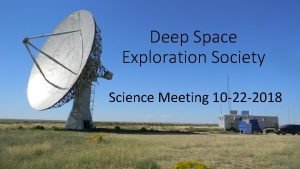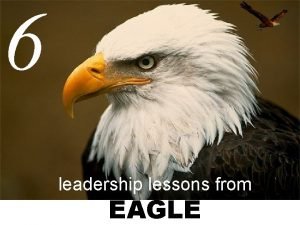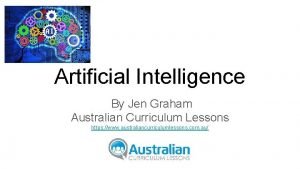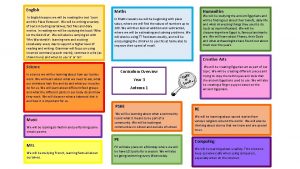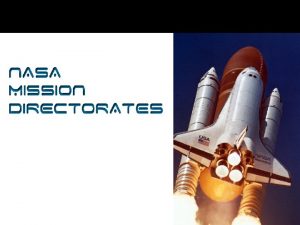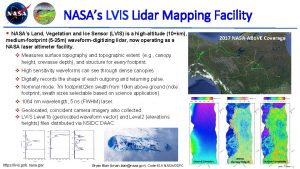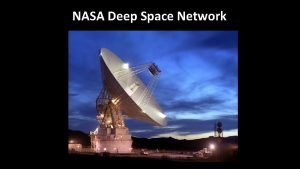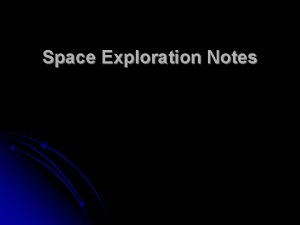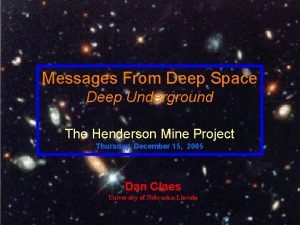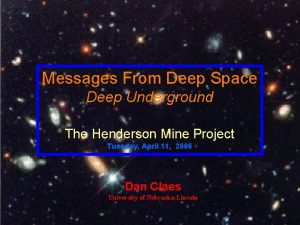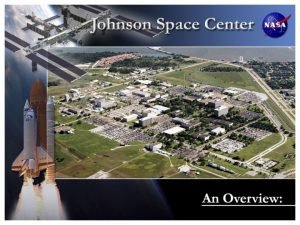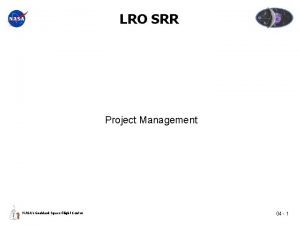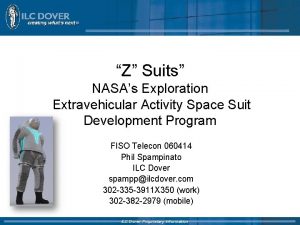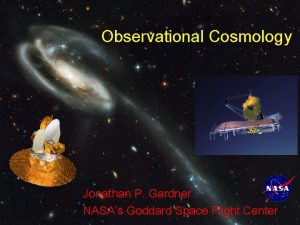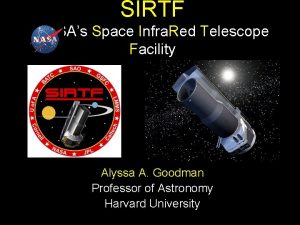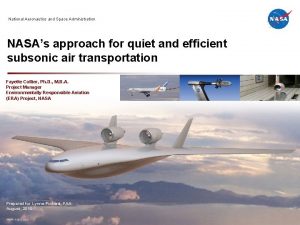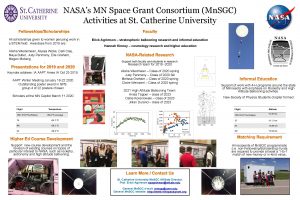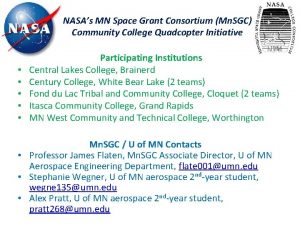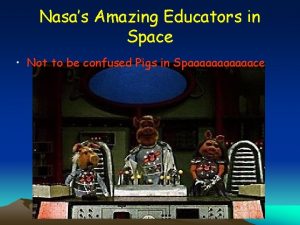AI in Space Lessons From NASAs Deep Space

































- Slides: 33

AI in Space – Lessons From NASA’s Deep Space 1 Mission Ron Keesing Dept. Of Maths & Computing Science University of the South Pacific

Overview • • • NASA’s Deep Space 1 Mission A brief introduction to AI Why use AI in space? The Remote Agent Future Directions

NASA’s Deep Space 1

NASA’s Deep Space 1 Technology • First mission of NASA’s New Millenium Program. • Primary mission goal was to demonstrate new technologies.

NASA’s Deep Space 1 Innovation First demonstration of • Ion Propulsion System Engine • AI system for spacecraft command control (Remote Agent) • 10 other technologies

NASA’s Deep Space 1 Ion Propulsion System Engine

NASA’s Deep Space 1 Exploration • Launched in October, 1998 • Successful flybys of – Asteroid Braille (26 Kms) • Closest asteroid approach to date – Comet Borrelly • Best data ever collected from comet

NASA’s Deep Space 1 Exploration – Launch

NASA’s Deep Space 1 Exploration – Artist’s conception

NASA’s Deep Space 1 Exploration - Encounter with Comet Borrelly

A Brief Introduction to AI • What is artificial intelligence? – Creating machines that behave “intelligently”. • How would you know an “intelligent” machine if you saw one? – The Turing Test

A Brief Introduction to AI • Early predictions (1950 s) were very optimistic. • Computers would soon: – Win World Chess Championship. – Understand spoken language. – Be as “smart” as people.

A Brief Introduction to AI • HAL-9000 from “ 2001 – A Space Odyssey”

A Brief Introduction to AI • HAL-9000 from “ 2001 – A Space Odyssey”

A Brief Introduction to AI • HAL-9000 from “ 2001 – A Space Odyssey”

A Brief Introduction to AI • Creating “intelligent” computers has proven far more difficult than imagined. – 50 years to beat world chess champion. – Not close to understanding language. – No one even thinks about a computer passing the Turing Test anymore…

A Brief Introduction to AI • Human beings are much smarter than we gave ourselves credit for. – Solving differential equations is easy. Catching a ball is hard. – Storing lots of information is easy. Understanding it is hard.

A Brief Introduction to AI • Even though AI is hard, we’ve developed a lot of ways to make machines “smarter”. – Planning – Automated Reasoning – Agents

A Brief Introduction to AI • Planning – Decomposing high-level goals into individual tasks that can achieve these goals efficiently • Robots that can manipulate objects. • Systems for optimizing manufacturing processes.

A Brief Introduction to AI • Automated Reasoning – Making inferences from limited information based on knowledge of the domain. • Medical diagnosis • Theorem proving

A Brief Introduction to AI • Agents – Systems that can perform complex tasks autonomously. • Web search agents that can navigate the web looking for specific pieces of information.

Why Use AI In Space? • Conventional model of spacecraft control – Ground control sends a plan. – Spacecraft executes that plan. – If anything goes wrong, spacecraft enters “safe mode” and calls ground control.

Why Use AI In Space? • Problems with “ground control” approach: – Expensive – May miss opportunities. – Sometimes it’s more dangerous to wait for help. – Some missions can’t be run from ground.

The Remote Agent • An autonomous system for spacecraft command control • 3 components – Planner – Inference system (MIR) – “Smart Executive”

The Remote Agent • Planner – Takes mission goals from ground control and creates a plan to satisfy them • Plans for limited resources (power). • Plans satisfy numerous constraints (orientation, communication, state of devices).

The Remote Agent • Planner Op. Nav IPS Thrust ACS Turns MICAS Power MICAS Imaging Nav OD Planning

The Remote Agent • Inference system (MIR) – Gets information from sensors. – Deduces state of spacecraft using modelbased reasoning. – Suggests ways to reconfigure if devices fail.

The Remote Agent • Inference system (MIR)

The Remote Agent • “Smart Executive” – Sends commands to spacecraft to execute the plan. – Executes the plan flexibly, including trying multiple methods if necessary. – Recognizes when a plan has failed and triggers replanning.

The Remote Agent • “Smart Executive” (to_achieve (IPS_THRUSTING ips level) ((ips_is_in_standby_state_p ips) (sequence (achieve (power_on? 'ega—a)) (command_with_confirmation (send—ips—set—thrust—level)) (command_with_confirmation (send—acs—change—control—mode : acs—tvc—mode)))) ((ips_in_thrusting_state_p ips) (command_with_confirmation (send—ips—change—thrust—level))) (t (fail : ips_achieve_thrusting)))

The Remote Agent Experiment • The Remote Agent took control of DS-1 for 3 days. – Validated all objectives • Demonstrated ability to formulate plans to satisfy mission goals. • Demonstrated ability to diagnose faults and reconfigure to perform tasks. • Demonstrated plan failure, recovery, and replanning.

The Remote Agent Experiment • Lessons from using AI on DS-1. – An autonomous system can successfully control a complex spacecraft. • Opens the door to new types of missions and a new relationship between ground and spacecraft. – The RA architecture is a powerful approach to building robust autonomous systems

Future Directions For AI In Space • • Autonomous rovers Manned mission to Mars Formation flying Many-agent approaches
 深哉深哉耶穌的愛
深哉深哉耶穌的愛 Deep asleep deep asleep it lies
Deep asleep deep asleep it lies Deep forest towards an alternative to deep neural networks
Deep forest towards an alternative to deep neural networks Pan's labyrinth mise en scene
Pan's labyrinth mise en scene Deep space exploration society
Deep space exploration society This insulates our earth from the deep cold of space
This insulates our earth from the deep cold of space Mise en scene
Mise en scene Camera space to world space
Camera space to world space Unscented trajectory chapter 5
Unscented trajectory chapter 5 Joint space vs cartesian space
Joint space vs cartesian space World space computer
World space computer Space junk the space age began
Space junk the space age began Life lessons from the book of job
Life lessons from the book of job Missouri comprehensive school counseling program
Missouri comprehensive school counseling program Lessons from the life of judas iscariot
Lessons from the life of judas iscariot Lessons about etps
Lessons about etps Lesson from hadith 17
Lesson from hadith 17 Marzano teacher evaluation model
Marzano teacher evaluation model Seeds quiz
Seeds quiz Lesson from eagle
Lesson from eagle Australian curriculum lessons
Australian curriculum lessons Six sigma lessons learned
Six sigma lessons learned Lessons from a pencil
Lessons from a pencil Word choice lessons
Word choice lessons Leviticus 10 1-3
Leviticus 10 1-3 Genesis 20-21
Genesis 20-21 Lessons from rocket singh movie
Lessons from rocket singh movie Exodus 32
Exodus 32 Firm behavior and the organization of industry
Firm behavior and the organization of industry Voice lessons nancy dean
Voice lessons nancy dean Mort janklow
Mort janklow Screwtape letters lessons
Screwtape letters lessons Mathsinenglish
Mathsinenglish What were daisy's assets as an eighteen year old
What were daisy's assets as an eighteen year old




